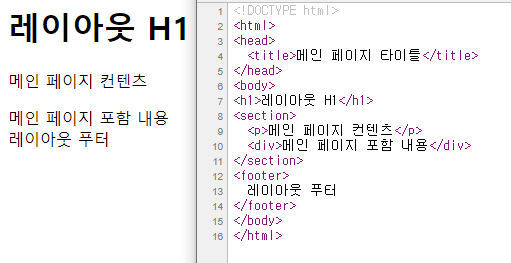
1. 텍스트 - text, utext
| 구분 | text | utext |
|---|---|---|
| escape | 사용 | 사용하지 않음 |
| 태그의 속성으로 값 출력 | th:text | th:utext |
| 직접 데이터 출력 | [[...]] | [(...)] |
사용 예
<h1>text vs utext</h1>
<ul>
<li>th:text = <span th:text="${data}"></span></li>
<li>th:utext = <span th:utext="${data}"></span></li>
</ul>
<h1><span th:inline="none">[[...]] vs [(...)]</span></h1>
<ul>
<li><span th:inline="none">[[...]] = </span>[[${data}]]</li>
<li><span th:inline="none">[(...)] = </span>[(${data})]</li>
</ul>출력
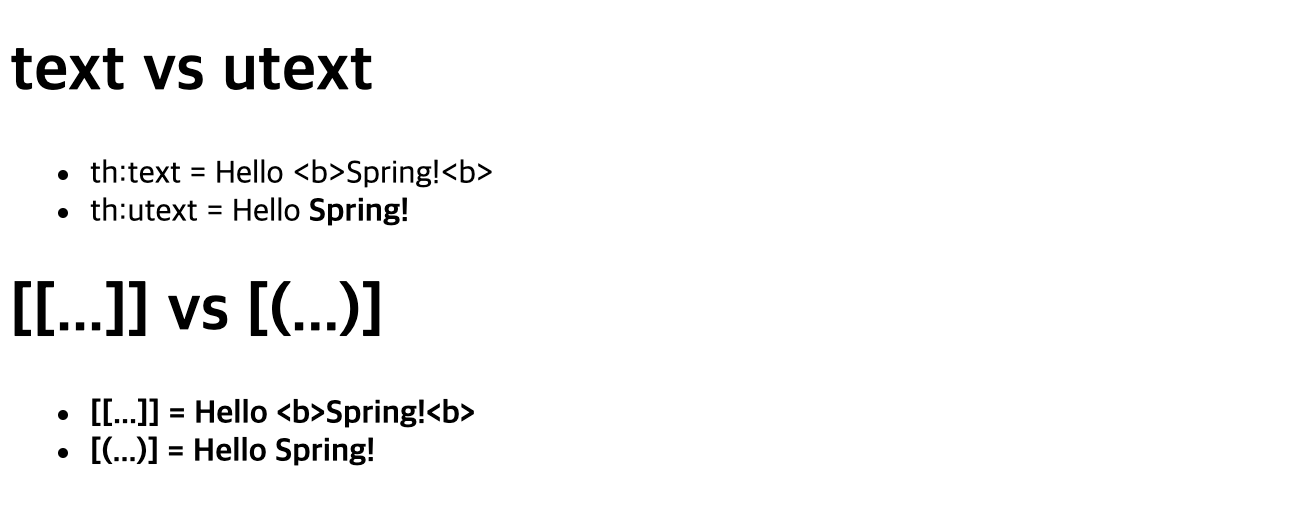
2. 변수 - SpringEL
- 변수 사용시 변수 표현식 사용 : ${...}
다양한 변수 접근 방법
- ex) User 클래스
public class User {
private String username;
private int age;
public User(String username, int age) {
this.username = username;
this.age = age;
}
}| Object | List | Map |
|---|---|---|
| ${user.username} | ${users[0].username} | ${userMap['userA'].username} |
| ${user['username']} | ${users[0]['username']} | ${userMap['userA']['username']} |
| ${user.getUsername()} | ${users[0].getUsername()} | ${userMap['userA'].getUsername()} |
지역변수 사용
1. th:with 태그 이용
2. 지역변수는 선언한 태그에서만 사용 가능
사용 예
<h1>SpringEL 표현식</h1>
<ul>Object
<li>${user.username} = <span th:text="${user.username}"></span></li>
<li>${user['username']} = <span th:text="${user['username']}"></span></li>
<li>${user.getUsername()} = <span th:text="${user.getUsername()}"></span></li>
</ul>
<ul>List
<li>${users[0].username} = <span th:text="${users[0].username}"></span>
</li>
<li>${users[0]['username']} = <span th:text="${users[0]['username']}"></span>
</li>
<li>${users[0].getUsername()} = <span th:text="${users[0].getUsername()}"></span></li>
</ul>
<ul>Map
<li>${userMap['userA'].username} = <span th:text="${userMap['userA'].username}"></span></li>
<li>${userMap['userA']['username']} = <span th:text="${userMap['userA']['username']}"></span></li>
<li>${userMap['userA'].getUsername()} = <span th:text="${userMap['userA'].getUsername()}"></span></li>
</ul>
<h1>지역 변수 - (th:with)</h1>
<div th:with="first=${users[0]}">
<p>처음 사람의 이름은 <span th:text="${first.username}"></span></p>
</div>출력
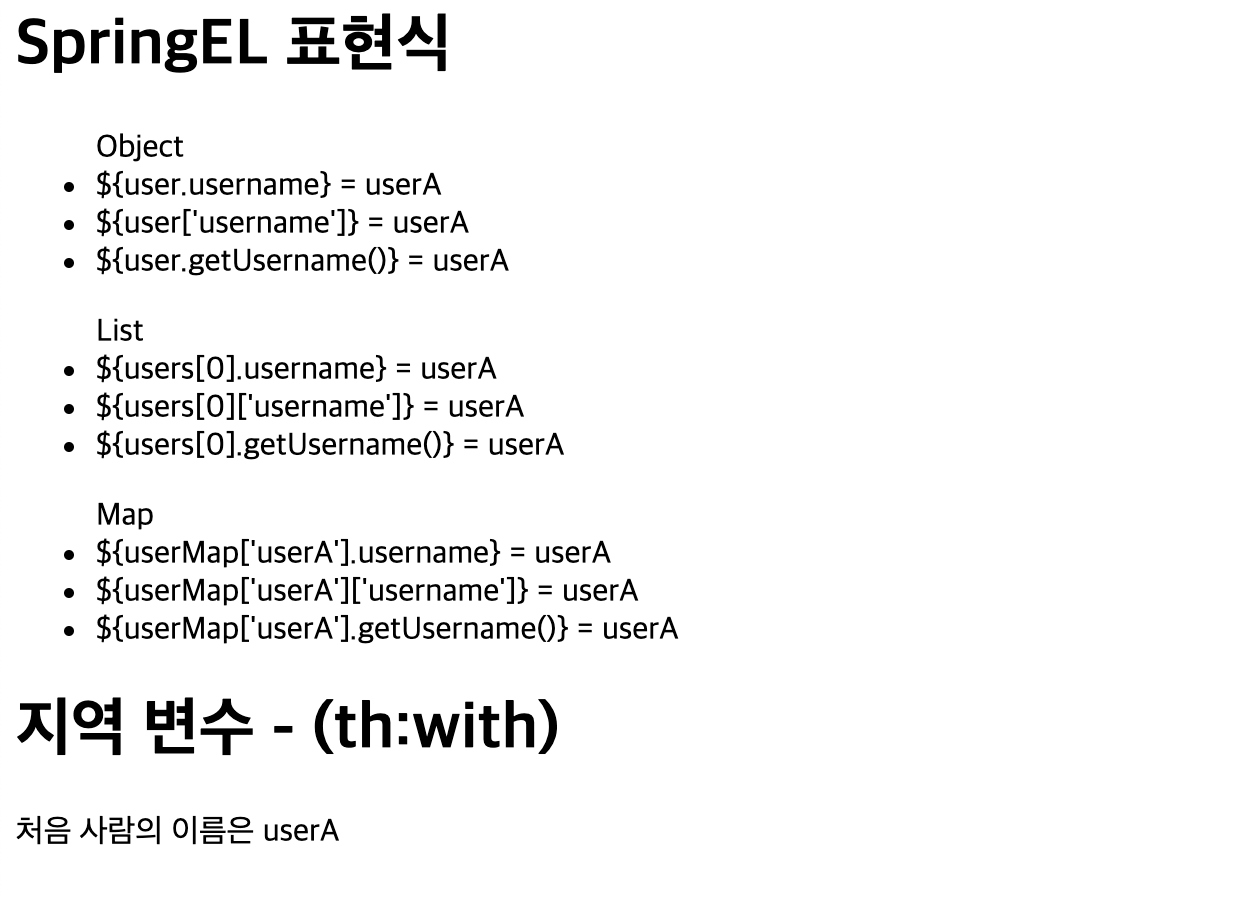
3. thymeleaf 기본객체들
ex) 스프링 빈 등록
@Component("helloBean")
public class HelloBean {
public String hello(String data) {
return "Hello" + data;
}
}| 객체 | 설명 |
|---|---|
| ${#request} | HttpRequest 객체 접근 |
| ${#response} | HttpResponse 객체 접근 |
| ${#session} | HttpSession 객체 접근 |
| ${#servletContext} | ServletContext 객체 접근 |
| ${#locale} | Locale 객체 접근 |
| ${param.paramData} | request.getParameter() |
| ${session.sessionData} | 세션 값 바로 사용 |
| ${@helloBean.hello('Spring!')} | Spring Bean에 바로 접근 |
사용 예
<h1>식 기본 객체 (Expression Basic Objects)</h1>
<ul>
<li>request = <span th:text="${#request}"></span></li>
<li>response = <span th:text="${#response}"></span></li>
<li>session = <span th:text="${#session}"></span></li>
<li>servletContext = <span th:text="${#servletContext}"></span></li>
<li>locale = <span th:text="${#locale}"></span></li>
</ul>
<h1>편의 객체</h1>
<ul>
<li>Request Parameter = <span th:text="${param.paramData}"></span></li>
<li>session = <span th:text="${session.sessionData}"></span></li>
<li>spring bean = <span th:text="${@helloBean.hello('Spring!')}"></span></li>
</ul>출력
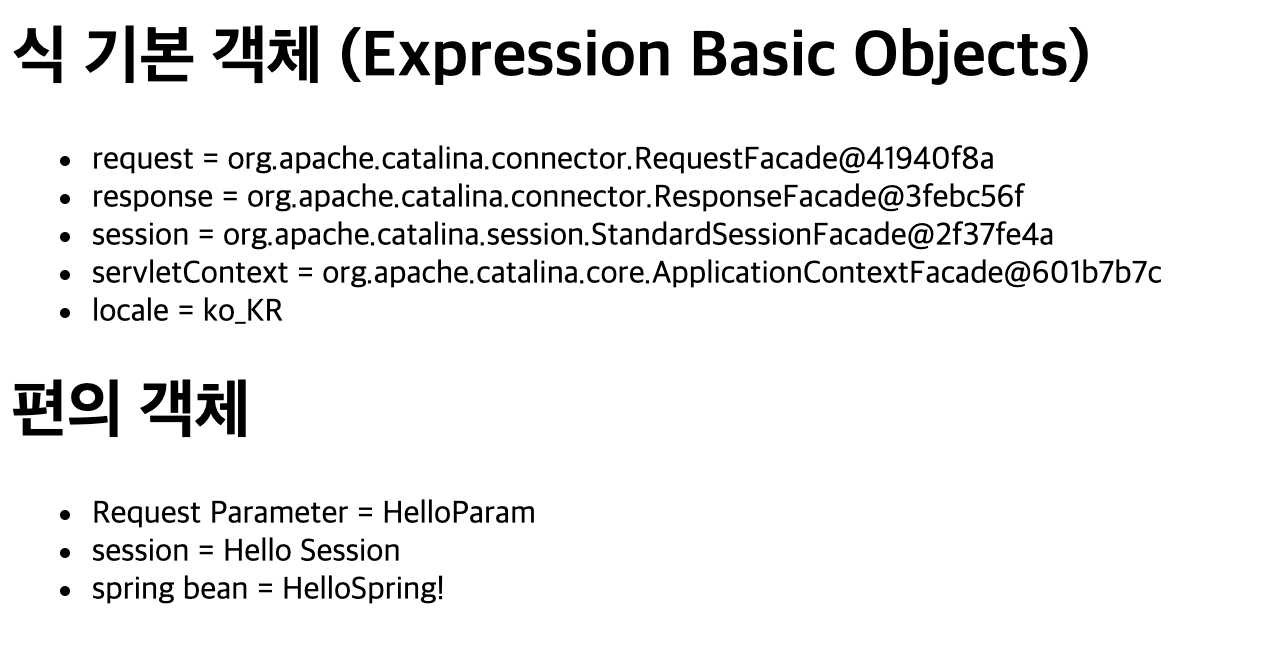
4. 유틸리티 객체와 날짜
| 객체 | 설명 |
|---|---|
| #message | 메시지, 국제화 처리 |
| #uris | URI 이스케이프 지원 |
| #dates | java.util.Date 서식 지원 #calendars : java.util.Calendar 서식 지원 |
| #temporals | 자바8 날짜 서식 지원 |
| #numbers | 숫자 서식 지원 |
| #strings | 문자 관련 편의 기능 |
| #objects | 객체 관련 기능 제공 |
| #bools | boolean 관련 기능 제공 |
| #arrays | 배열 관련 기능 제공 |
| #lists , #sets , #maps | 컬렉션 관련 기능 제공 |
| #ids | 아이디 처리 관련 기능 제공, 뒤에서 설명 |
사용법
자바8 날짜
- 타임리프에서 LocalDateTime, LocalDate, Instance를 사용할 수 있다.
- 라이브러리 추가 필요 (spring boot starter thymeleaf 사용 시 자동 추가)
thymeleaf-extras-java8time- #temporals 로 사용할 수 있다.
사용 예
- ${localDateTime} 의 경우 Model에 담겨 넘어온 값
<ul>
<li>default = <span th:text="${localDateTime}"></span></li>
<li>yyyy-MM-dd HH:mm:ss = <span th:text="${#temporals.format(localDateTime,'yyyy-MM-dd HH:mm:ss')}"></span></li>
</ul>
<h1>LocalDateTime - Utils</h1>
<ul>
<li>${#temporals.day(localDateTime)} = <span th:text="${#temporals.day(localDateTime)}"></span></li>
<li>${#temporals.month(localDateTime)} = <span th:text="${#temporals.month(localDateTime)}"></span></li>
<li>${#temporals.monthName(localDateTime)} = <span th:text="${#temporals.monthName(localDateTime)}"></span></li>
<li>${#temporals.monthNameShort(localDateTime)} = <span th:text="${#temporals.monthNameShort(localDateTime)}"></span></li>
<li>${#temporals.year(localDateTime)} = <span th:text="${#temporals.year(localDateTime)}"></span></li>
<li>${#temporals.dayOfWeek(localDateTime)} = <span th:text="${#temporals.dayOfWeek(localDateTime)}"></span></li>
<li>${#temporals.dayOfWeekName(localDateTime)} = <span th:text="${#temporals.dayOfWeekName(localDateTime)}"></span></li>
<li>${#temporals.dayOfWeekNameShort(localDateTime)} = <span th:text="${#temporals.dayOfWeekNameShort(localDateTime)}"></span></li>
<li>${#temporals.hour(localDateTime)} = <span th:text="${#temporals.hour(localDateTime)}"></span></li>
<li>${#temporals.minute(localDateTime)} = <span th:text="${#temporals.minute(localDateTime)}"></span></li>
<li>${#temporals.second(localDateTime)} = <span th:text="${#temporals.second(localDateTime)}"></span></li>
<li>${#temporals.nanosecond(localDateTime)} = <span th:text="${#temporals.nanosecond(localDateTime)}"></span></li>
</ul>출력
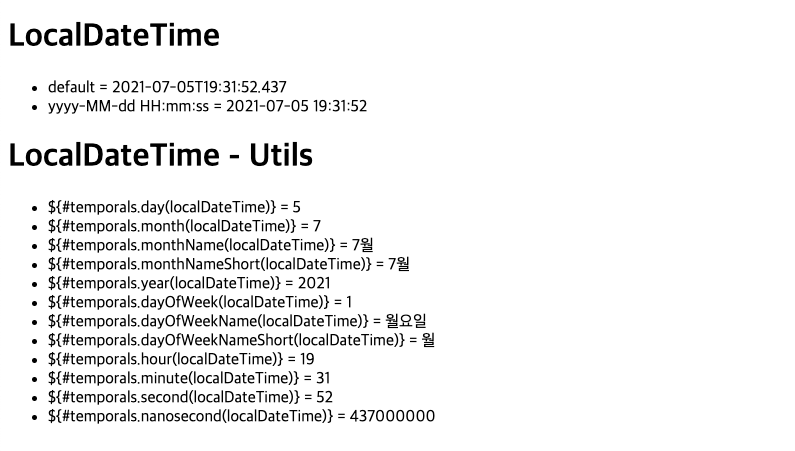
5. URL 링크
-Model객체에 데이터 저장
public String link(Model model) {
model.addAttribute("param1", "data1");
model.addAttribute("param2", "data2");
return "basic/link";
}| URL 유형 | 설명 |
|---|---|
| 단순한 URL | @{/hello} -> /hello |
| 쿼리 파라미터 | @{/hello(param1={param2})} |
-> /hello?param1=data1¶m2=data2 | |
| -> () 에 있는 부분은 쿼리 파라미터로 처리된다. | |
| 경로 변수 | @{/hello/{param1}/{param2}(param1={param2})} |
| -> /hello/data1/data2 | |
| -> URL 경로상에 변수가 있으면 () 부분은 경로 변수로 처리된다. | |
| 경로 변수 + 쿼리 파라미터 | @{/hello/{param1}(param1={param2})} |
| -> /hello/data1?param2=data2 | |
| -> 경로 변수와 쿼리 파라미터를 함께 사용할 수 있다. |
- 상대경로, 절대경로 표현
- /hello : 절대 경로
- hello : 상대 경로
사용 예
<h1>URL 링크</h1>
<ul>
<li><a th:href="@{/hello}">basic url</a></li>
<li><a th:href="@{/hello(param1=${param1}, param2=${param2})}">hello query param</a></li>
<li><a th:href="@{/hello/{param1}/{param2}(param1=${param1}, param2=${param2})}">path variable</a></li>
<li><a th:href="@{/hello/{param1}(param1=${param1}, param2=${param2})}">path variable + query parameter</a></li>
</ul>출력

6. 리터럴
- 리터럴은 소스 코드상에 고정된 값을 말하는 용어이다.
- 타임리프에서 문자 리터럴은 항상 ' (작은 따옴표)로 감싸야 한다.
| 리터럴 | 사용 |
|---|---|
| 문자 | 'hello' |
| 숫자 | 10 |
| 불린 | true , false |
| null | null |
- 리터럴 대체(Literal substitutions)
|...| 로 감싸 대체 할 수 있다.
사용 예
<ul>
<li>'hello' + ' world!' = <span th:text="'hello' + ' world!'"></span></li>
<li>'hello world!' = <span th:text="'hello world!'"></span></li>
<li>'hello ' + ${data} = <span th:text="'hello ' + ${data}"></span></li>
<li>리터럴 대체 |hello ${data}| = <span th:text="|hello ${data}|"></span></li>
</ul>출력

7. 연산
| 연산 | 사용 |
|---|---|
| 비교연산 | HTML 엔티티를 사용해야 하는 부분을 주의 |
| > (gt), < (lt), >= (ge), <= (le), ! (not), == (eq), != (neq, ne) | |
| 조건식 | 자바의 조건식과 유사하다. |
| Elvis 연산자 | 조건식의 편의 버전 |
| No-Operation | _ 인 경우 마치 타임리프가 실행되지 않는 것 처럼 동작한다. |
| 이것을 잘 사용하면 HTML 의 내용 그대로 활용할 수 있다. | |
| 마지막 예를 보면 데이터가 없습니다. 부분이 그대로 출력된다. |
사용 예
<ul>
<li>산술 연산
<ul>
<li>10 + 2 = <span th:text="10 + 2"></span></li>
<li>10 % 2 == 0 = <span th:text="10 % 2 == 0"></span></li>
</ul>
</li>
<li>비교 연산
<ul>
<li>1 > 10 = <span th:text="1 > 10"></span></li>
<li>1 gt 10 = <span th:text="1 gt 10"></span></li>
<li>1 >= 10 = <span th:text="1 >= 10"></span></li>
<li>1 ge 10 = <span th:text="1 ge 10"></span></li>
<li>1 == 10 = <span th:text="1 == 10"></span></li>
<li>1 != 10 = <span th:text="1 != 10"></span></li>
</ul>
</li>
<li>조건식
<ul>
<li>(10 % 2 == 0)? '짝수':'홀수' = <span th:text="(10 % 2 == 0)? '짝수':'홀수'"></span></li>
</ul>
</li>
<li>Elvis 연산자
<ul>
<li>${data}?: '데이터가 없습니다.' = <span th:text="${data}?: '데이터가 없습니다.'"></span></li>
<li>${nullData}?: '데이터가 없습니다.' = <span th:text="${nullData}?: '데이터가 없습니다.'"></span></li>
</ul>
</li>
<li>No-Operation
<ul>
<li>${data}?: _ = <span th:text="${data}?: _">데이터가 없습니다.</span></li>
<li>${nullData}?: _ = <span th:text="${nullData}?: _">데이터가 없습니다.</span></li>
</ul>
</li>
</ul>출력
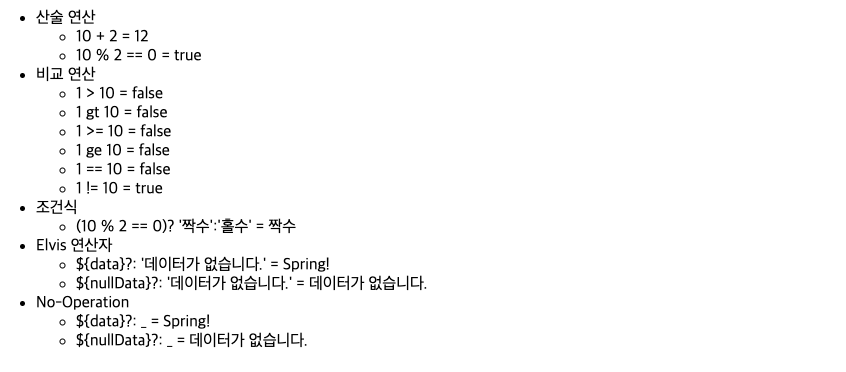
8. 속성 값 설정
- 타임리프 태그 속성(Attribute)
- 타임리프는 주로 HTML 태그에 th: 속성을 지정하는 방식으로 동작한다. th: 로 속성을 적용하면 기존
속성을 대체한다. 기존 속성이 없으면 새로 만든다.
| 속성 값 설정 | 사용 |
|---|---|
| 속성 설정 | th: 속성을 지정하면 타임리프는 기존 속성을 th: 로 지정한 속성으로 대체한다. |
| 기존 속성이 없다면 새로 만든다. | |
| 속성 추가 | th:attrappend : 속성 값의 값에 값을 추가한다. |
| th:attrprepend : 속성 값의 뒤에 값을 추가한다. | |
| th:classappend : class 속성에 자연스럽게 추가한다. | |
| checked 처리 | HTML에서 checked 속성은 checked 속성의 값과 상관없이 checked 라는 속성만 있어도 체크가 된다. |
| 타임리프의 th:checked 는 값이 false 인 경우 checked 속성 자체를 제거한다. |
사용 예
<h1>속성 설정</h1>
<input type="text" name="mock" th:name="userA"/>
<h1>속성 추가</h1>
- th:attrappend = <input type="text" class="text" th:attrappend="class=' large'"/><br/>
- th:attrprepend = <input type="text" class="text" th:attrprepend="class='large '"/><br/>
- th:classappend = <input type="text" class="text" th:classappend="large" /><br/>
<h1>checked 처리</h1>
- checked o <input type="checkbox" name="active" th:checked="true"/><br/>
- checked x <input type="checkbox" name="active" th:checked="false"/><br/>
- checked=false <input type="checkbox" name="active" checked="false"/><br/>출력
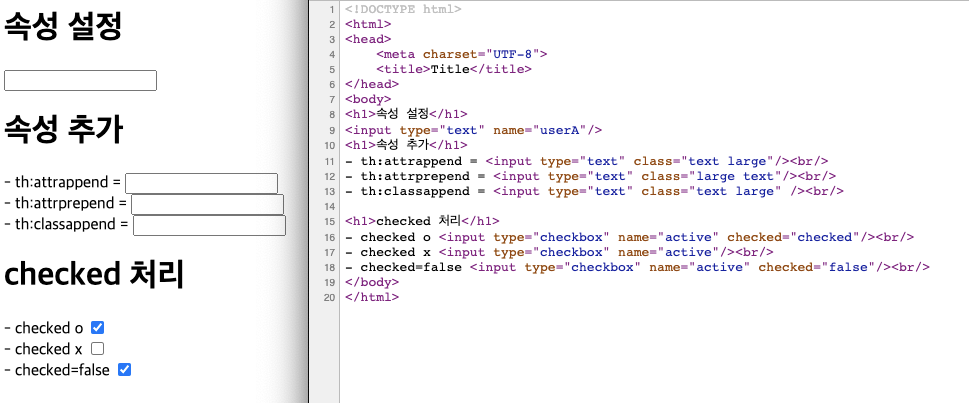
9. 반복
- 데이터 생성
...
List<User> list = new ArrayList<>();
list.add(new User("userA", 10));
list.add(new User("userB", 20));
list.add(new User("userC", 30));
model.addAttribute("users", list);
...| 반복 | 사용 |
|---|---|
| 반복 기능 | <tr th:each="user : ${users}"> |
| 반복시 오른쪽 컬렉션( ${users} )의 값을 하나씩 꺼내서 왼쪽 변수( user )에 담아서 태그를 반복 | |
| th:each 는 List 뿐만 아니라 배열, java.util.Iterable , java.util.Enumeration 을 구현한 모든 객체를 반복에 사용가능 | |
| Map 도 사용할 수 있는데 이 경우 변수에 담기는 값은 Map.Entry | |
| 반복 상태 유지 | <tr th:each="user, userStat : ${users}"> |
| 반복의 두번째 파라미터를 설정해서 반복의 상태를 확인 가능 | |
| 두번째 파라미터는 생략 가능한데, 생략하면 지정한 변수명( user ) + Stat | |
| 반복 상태 유지 기능 | index : 0부터 시작하는 값 |
| count : 1부터 시작하는 값 | |
| size : 전체 사이즈 | |
| even , odd : 홀수, 짝수 여부( boolean ) | |
| first , last :처음, 마지막 여부( boolean ) | |
| current : 현재 객체 |
사용 예
<h1>기본 테이블</h1>
<table border="1">
<tr>
<th>username</th>
<th>age</th>
</tr>
<tr th:each="user : ${users}">
<td th:text="${user.username}">username</td>
<td th:text="${user.age}">0</td>
</tr>
</table>
<h1>반복 상태 유지</h1>
<table border="1">
<tr>
<th>count</th>
<th>username</th>
<th>age</th>
<th>etc</th>
</tr>
<tr th:each="user, userStat : ${users}">
<td th:text="${userStat.count}">username</td>
<td th:text="${user.username}">username</td>
<td th:text="${user.age}">0</td>
<td>
index = <span th:text="${userStat.index}"></span>
count = <span th:text="${userStat.count}"></span>
size = <span th:text="${userStat.size}"></span>
even? = <span th:text="${userStat.even}"></span>
odd? = <span th:text="${userStat.odd}"></span>
first? = <span th:text="${userStat.first}"></span>
last? = <span th:text="${userStat.last}"></span>
current = <span th:text="${userStat.current}"></span>
</td>
</tr>
</table>출력
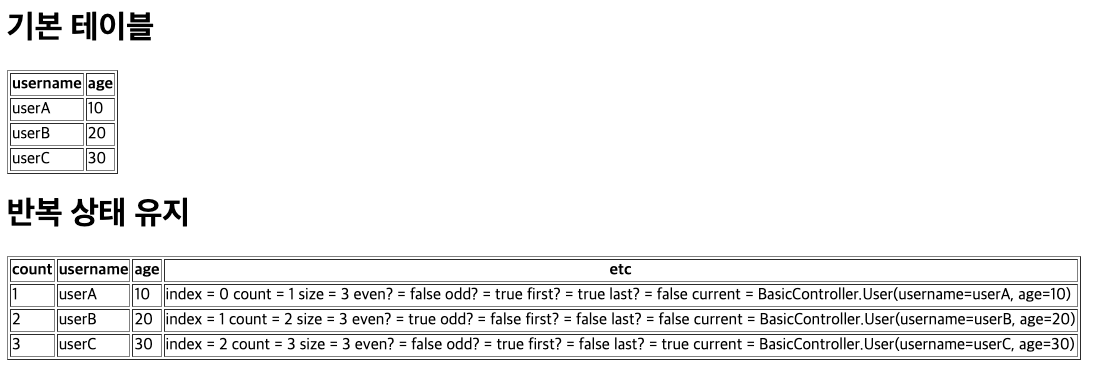
10. 조건부 평가
| 조건식 | 사용 |
|---|---|
| if, unless | if : 조건 만족 시 렌더링 |
| unless : 조건이 만족하지 않을 시 렌더링 | |
| 타임리프는 해당 조건이 맞지 않으면 태그 자체를 렌더링하지 않는다. | |
만약 다음 조건이 false 인 경우 <span>...<span> 부분 자체가 렌더링 되지 않고 사라진다. | |
<span th:text="'미성년자'" th:if="${user.age lt 20}"></span> | |
| switch | * 은 만족하는 조건이 없을 때 사용하는 디폴트이다. |
사용 예
<table border="1">
<tr>
<th>count</th>
<th>username</th>
<th>age</th>
</tr>
<tr th:each="user, userStat : ${users}">
<td th:text="${userStat.count}">1</td>
<td th:text="${user.username}">username</td>
<td>
<span th:text="${user.age}">0</span>
<span th:text="'미성년자'" th:if="${user.age lt 20}"></span> <span th:text="'미성년자'" th:unless="${user.age ge 20}"></span>
</td>
</tr>
</table>
<h1>switch</h1>
<table border="1">
<tr>
<th>count</th>
<th>username</th>
<th>age</th>
</tr>
<tr th:each="user, userStat : ${users}">
<td th:text="${userStat.count}">1</td>
<td th:text="${user.username}">username</td>
<td th:switch="${user.age}">
<span th:case="10">10살</span> <span th:case="20">20살</span> <span th:case="*">기타</span>
</td>
</tr>
</table>출력
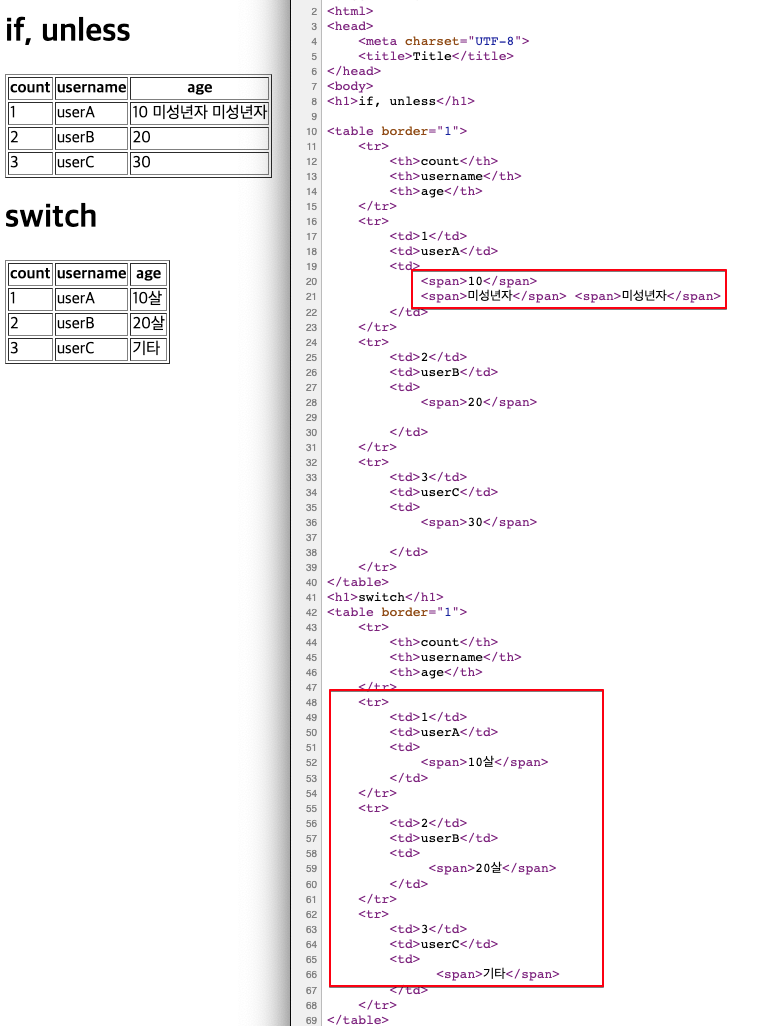
11. 주석
| 주석 | 사용 |
|---|---|
| 표준 HTML 주석 | 자바스크립트의 표준 HTML 주석은 타임리프가 렌더링 하지 않고, 그대로 남겨둔다. |
| 타임리프 파서 주석 | 타임리프 파서 주석은 타임리프의 진짜 주석이다. 렌더링에서 주석 부분을 제거한다. |
| 타임리프 프로토타입 주석 | HTML 주석에 약간의 구문을 더했다. |
| HTML 파일을 웹 브라우저에서 그대로 열어보면 HTML 주석이기 때문에 이 부분이 웹 브라우저가 렌더링하지 않는다. | |
| 타임리프 렌더링을 거치면 이 부분이 정상 렌더링 된다. | |
| HTML 파일을 그대로 열어보면 주석처리가 되지만, 타임리프를 렌더링 한 경우에만 보이는 기능이다. |
사용 예
<h1>예시</h1>
<span th:text="${data}">html data</span>
<h1>1. 표준 HTML 주석</h1>
<!--
<span th:text="${data}">html data</span>
-->
<h1>2. 타임리프 파서 주석</h1>
<!--/*
[[${data}]]
*/-->
<!--/*-->
<span th:text="${data}">html data</span>
<!--*/-->
<h1>3. 타임리프 프로토타입 주석</h1>
<!--/*/
<span th:text="${data}">html data</span>
/*/-->출력
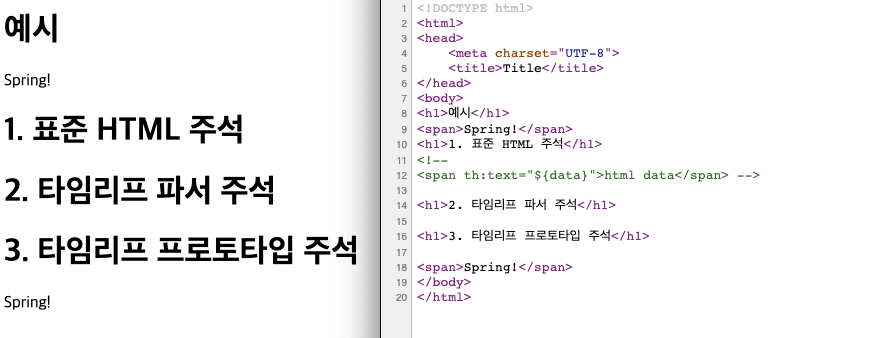
12. 블록
- <th:block> 은 HTML 태그가 아닌 타임리프의 유일한 자체 태그다.
- 타임리프의 특성상 HTML 태그안에 속성으로 기능을 정의해서 사용하는데, 여러 태그를 반복할 경우 사용 한다. <th:block> 은 렌더링시 제거된다.
사용 예
<th:block th:each="user : ${users}">
<div>
사용자 이름1 <span th:text="${user.username}"></span>
사용자 나이1 <span th:text="${user.age}"></span>
</div>
<div>
요약 <span th:text="${user.username} + ' / ' + ${user.age}"></span>
</div>
</th:block>출력

13. 자바스크립트 인라인
- 자바스크립트에서 타임리프를 편리하게 사용
<script th:inline="javascript">로 사용
| 사용 | 설명 |
|---|---|
| 텍스트 렌더링 | var username = [[${user.username}]]; |
| 인라인 사용 전 var username = userA; | |
| 인라인 사용 후 var username = "userA"; | |
| 내추럴 템플릿 | var username2 = /[[${user.username}]]/ "test username"; |
| 인라인 사용 전 var username2 = /userA/ "test username"; | |
| 인라인 사용 후 var username2 = "userA"; | |
| 객체 | var user = [[${user}]]; |
| 인라인 사용 전 var user = BasicController.User(username=userA, age=10); | |
| 인라인 사용 후 var user = {"username":"userA","age":10}; | |
| each | [# th:each="user, stat : ${users}"] |
사용 예
<!-- 자바스크립트 인라인 사용 전 -->
<script>
var username = [[${user.username}]];
var age = [[${user.age}]];
//자바스크립트 내추럴 템플릿
var username2 = /*[[${user.username}]]*/ "test username";
//객체
var user = [[${user}]];
</script>
<!-- 자바스크립트 인라인 사용 후 -->
<script th:inline="javascript">
var username = [[${user.username}]];
var age = [[${user.age}]];
//자바스크립트 내추럴 템플릿
var username2 = /*[[${user.username}]]*/ "test username";
//객체
var user = [[${user}]];
</script>
<!-- 자바스크립트 인라인 each -->
<script th:inline="javascript">
[# th:each="user, stat : ${users}"]
var user[[${stat.count}]] = [[${user}]];
[/]
</script>출력
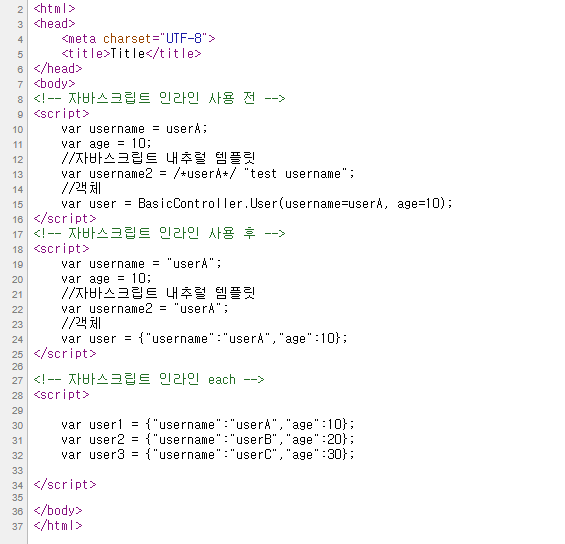
14. 템플릿 조각
- 공통 부분을 다른 페이지에서 불러 사용할 수 있다.
- ~{...} 로 사용한다. 파라미터 전달이 없으면 생략가능
- fragment 의 이름으로 페이지를 불러올 수 있다.
| 사용 | 설명 |
|---|---|
| 부분 포함 insert | <div th:insert="~{template/fragment/footer :: copy}"></div> |
| 현재 div 태그안에 불러온다. | |
| 부분 포함 replace | <div th:replace="~{template/fragment/footer :: copy}"></div> |
| 현재 태그를 교체한다. | |
| 파라미터 사용 | <div th:replace="~{template/fragment/footer :: copyParam ('데이터1', '데이터2')}"></div> |
| 파라미터를 전달 |
사용 예
- footer 템플릿 조각
<footer th:fragment="copy">
푸터 자리 입니다.
</footer>
<footer th:fragment="copyParam (param1, param2)">
<p>파라미터 자리 입니다.</p>
<p th:text="${param1}"></p>
<p th:text="${param2}"></p>
</footer>- 템플릿 조각 불러오기
<h1>부분 포함</h1>
<h2>부분 포함 insert</h2>
<div th:insert="~{template/fragment/footer :: copy}"></div>
<h2>부분 포함 replace</h2>
<div th:replace="~{template/fragment/footer :: copy}"></div>
<h2>부분 포함 단순 표현식</h2>
<div th:replace="template/fragment/footer :: copy"></div>
<h1>파라미터 사용</h1>
<div th:replace="~{template/fragment/footer :: copyParam ('데이터1', '데이터2')}"></div>
</body>출력
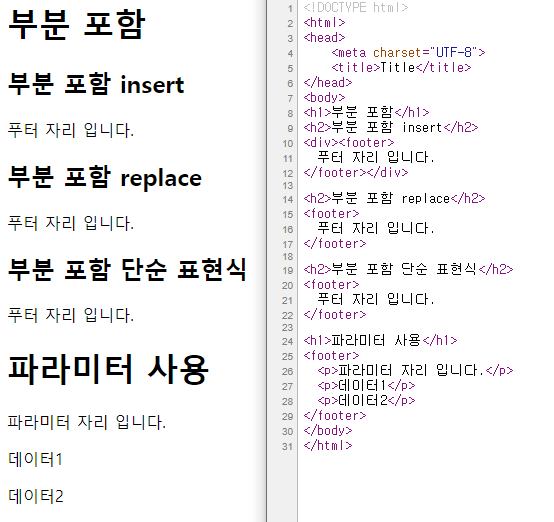
15. 템플릿 레이아웃
- 코드 조각을 레이아웃에 넘겨서 사용 할 수 있다.
- 기본적으로 공통 코드를 모아두고, 각 페이지 마다 필요한 정보를 추가해서 사용 할 때 사용할 수 있다.
사용 예
- 공통 코드
<html xmlns:th="http://www.thymeleaf.org">
<head th:fragment="common_header(title,links)">
<title th:replace="${title}">레이아웃 타이틀</title>
<!-- 공통 -->
<link rel="stylesheet" type="text/css" media="all" th:href="@{/css/awesomeapp.css}">
<link rel="shortcut icon" th:href="@{/images/favicon.ico}">
<script type="text/javascript" th:src="@{/sh/scripts/codebase.js}"></script>
<!-- 추가 -->
<th:block th:replace="${links}" />
</head>
</html>- 코드 사용
<!DOCTYPE html>
<html xmlns:th="http://www.thymeleaf.org">
<head th:replace="template/layout/base :: common_header(~{::title},~{::link})">
<title>메인 타이틀</title>
<link rel="stylesheet" th:href="@{/css/bootstrap.min.css}">
<link rel="stylesheet" th:href="@{/themes/smoothness/jquery-ui.css}">
</head>
<body>
메인 컨텐츠
</body>
</html>출력
- 전달한
<title>로 교체 - 추가부분에 전달한
<link>태그 추가

16. 템플릿 레이아웃 상속
<html>전체로 적용할 수 있다.- 기본 레이아웃에 컨텐츠 내용이 달라질 경우 사용
사용 예
- 기본 레이아웃
<!DOCTYPE html>
<html th:fragment="layout (title, content)" xmlns:th="http://www.thymeleaf.org">
<head>
<title th:replace="${title}">레이아웃 타이틀</title>
</head>
<body>
<h1>레이아웃 H1</h1>
<div th:replace="${content}">
<p>레이아웃 컨텐츠</p>
</div>
<footer>
레이아웃 푸터
</footer>
</body>
</html>- 사용 페이지
<!DOCTYPE html>
<html th:replace="~{template/layoutExtend/layoutFile :: layout(~{::title}, ~{::section})}"
xmlns:th="http://www.thymeleaf.org">
<head>
<title>메인 페이지 타이틀</title>
</head>
<body>
<section>
<p>메인 페이지 컨텐츠</p>
<div>메인 페이지 포함 내용</div>
</section>
</body>
</html>출력
- 기본 레이아웃에서 타이틀과 내용이 변경
